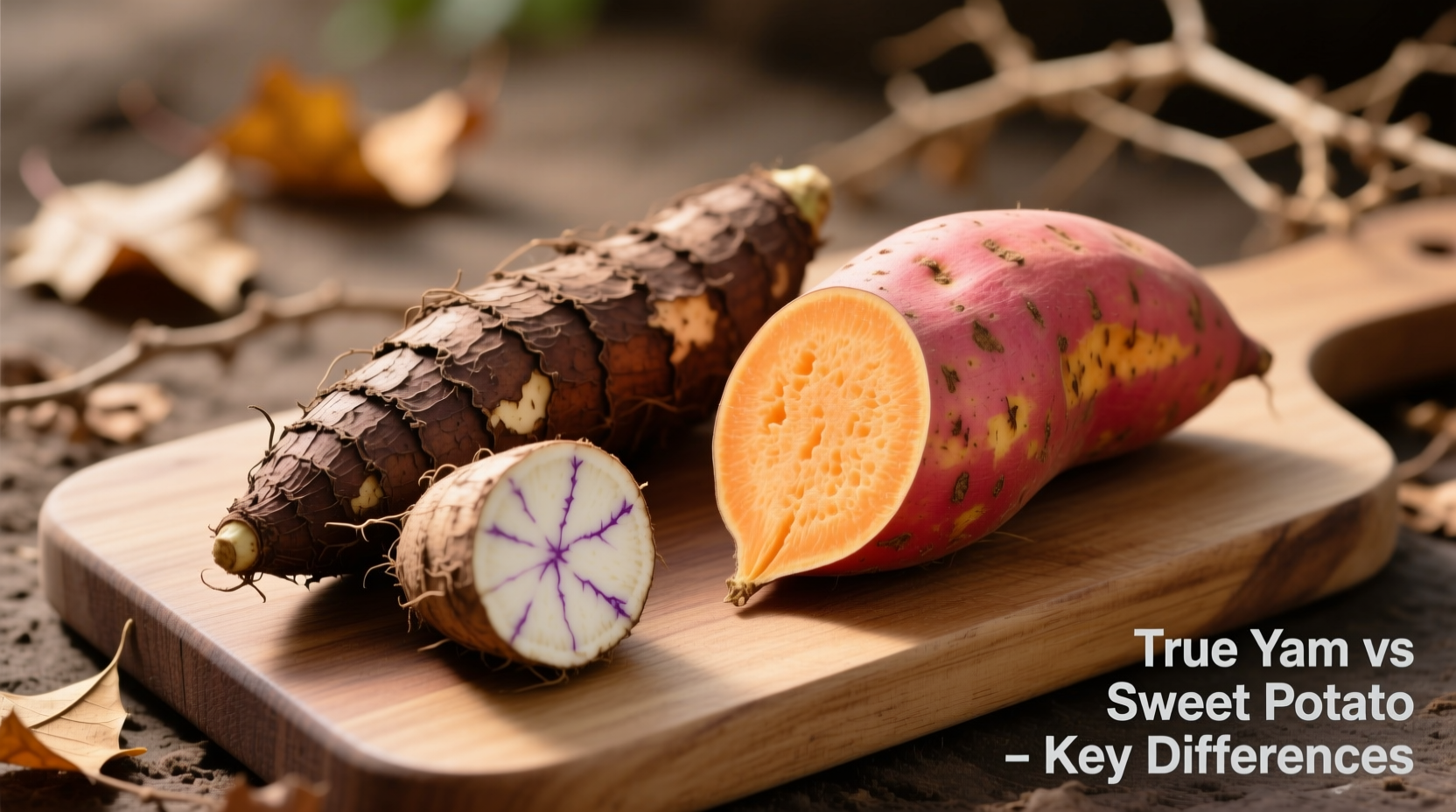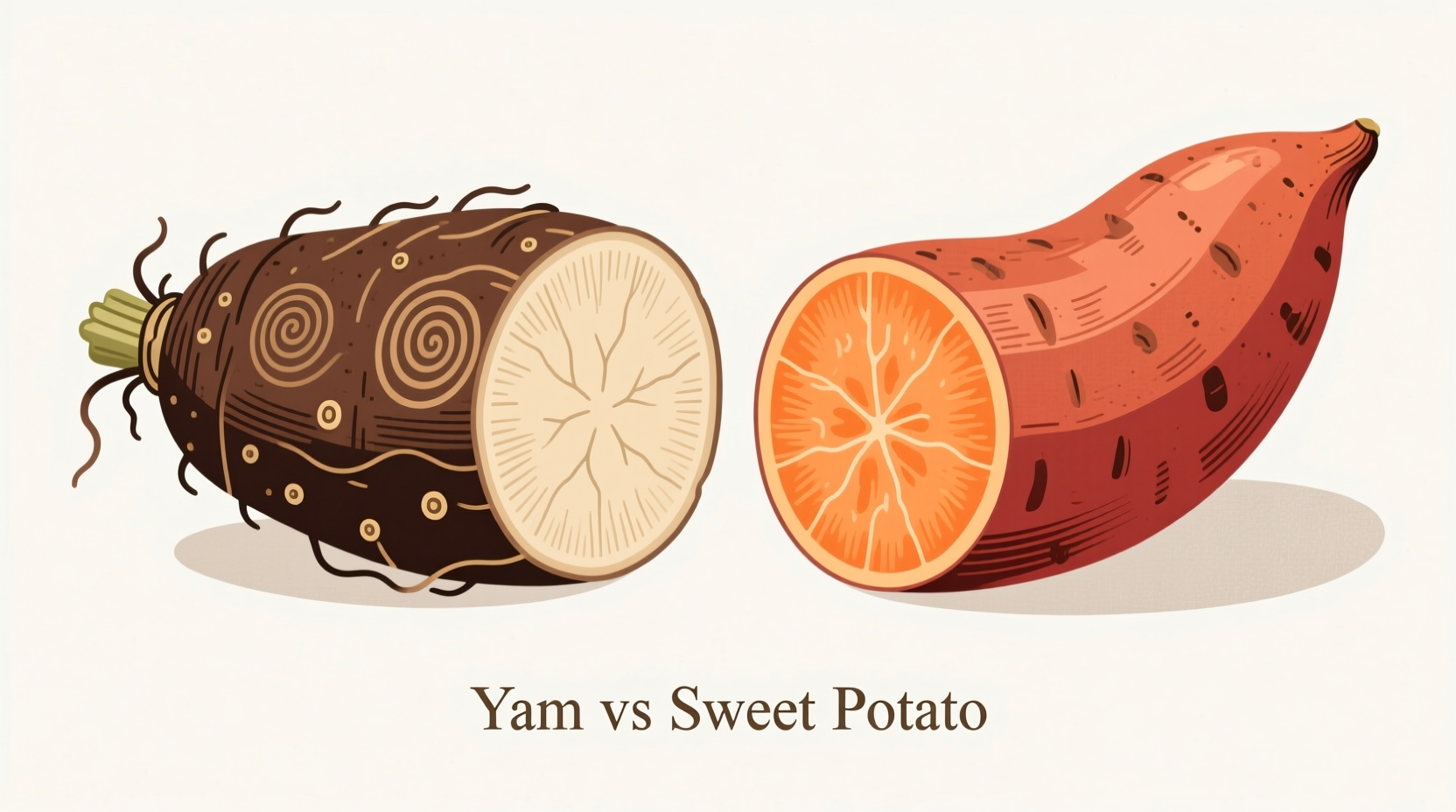Ever reached for "yams" at your local supermarket only to discover you've actually picked up orange-fleshed sweet potatoes? You're not alone. This widespread confusion affects millions of shoppers who believe they're purchasing the same vegetable under different names. Understanding the real differences between these two tubers isn't just botanical trivia—it directly impacts your cooking results, nutritional intake, and culinary authenticity.
Botanical Breakdown: Why They're Fundamentally Different
At the most basic level, yams and sweet potatoes come from entirely different plant families. True yams (Dioscorea genus) belong to the Dioscoreaceae family, while sweet potatoes (Ipomoea batatas) are part of the Convolvulaceae (morning glory) family. This botanical distinction explains their vastly different characteristics.
| Characteristic | True Yam | Sweet Potato |
|---|---|---|
| Scientific Family | Dioscoreaceae | Convolvulaceae |
| Origin | Africa, Asia | Central/South America |
| Texture | Dry, starchy, firm | Moist, soft, creamy |
| Skin | Bark-like, rough, brown | Thin, smooth, reddish-brown |
| Flesh Color | White, purple, or reddish | Orange, white, or purple |
| Sugar Content | Low | High |
This fundamental botanical difference explains why you can't substitute one for the other in traditional recipes without altering the dish's texture and flavor profile. True yams maintain their structure when cooked, making them ideal for stews, while sweet potatoes break down more readily, perfect for purees and desserts.
The Great American Labeling Confusion
The reason for widespread confusion dates back to early 20th century America. When soft varieties of sweet potatoes were introduced to distinguish them from firmer varieties, marketers began calling them "yams" to evoke the African heritage of many sweet potato consumers. The U.S. Department of Agriculture now requires that any product labeled as "yam" must also include the term "sweet potato" to prevent consumer deception.
According to historical records from the National Agricultural Library, this marketing strategy began around 1930 when Louisiana sweet potato growers wanted to differentiate their moist-fleshed varieties from the drier types grown elsewhere. The term "yam" was borrowed from the African word "nyami," meaning "to eat," but applied incorrectly to sweet potatoes.

Nutritional Differences That Matter
While both provide valuable nutrients, their nutritional profiles differ significantly. Data from the USDA FoodData Central shows that sweet potatoes contain substantially more beta-carotene (which converts to vitamin A) than true yams. A medium sweet potato provides over 400% of your daily vitamin A needs, while yams contain minimal amounts.
Yams, however, contain more potassium and manganese. They're also higher in complex carbohydrates and lower in sugar, making them a better option for those managing blood sugar levels. Sweet potatoes' vibrant orange color comes from beta-carotene, while purple varieties contain anthocyanins—powerful antioxidants also found in blueberries.
Where to Find Real Yams (and How to Use Them)
True yams are rarely found in standard American supermarkets. Your best bet is international markets specializing in African, Caribbean, or Asian foods. When shopping, look for these identifying features:
- Rough, bark-like skin that's difficult to peel
- Cylindrical shape, often quite large (some varieties grow over 6 feet long)
- White, purple, or reddish flesh (never orange)
- Starchy, less sweet taste when cooked
When cooking with true yams, remember they require longer cooking times than sweet potatoes. They're traditionally boiled, fried, or added to soups and stews in African and Caribbean cuisines. Unlike sweet potatoes, yams shouldn't be roasted or baked as their starch content makes them too dry when prepared this way.
Practical Tips for Confident Shopping
Next time you're at the grocery store, use these quick identification methods:
- Check the label - If it says "yam" without mentioning sweet potato, it's probably still a sweet potato
- Examine the skin - True yams have rough, scaly skin; sweet potatoes have smoother skin
- Consider the color - Orange flesh means it's definitely a sweet potato
- Feel the texture - Yams feel harder and denser than sweet potatoes
Understanding these differences empowers you to make informed choices based on your culinary needs. Want that classic Thanksgiving casserole? You need orange-fleshed sweet potatoes. Planning an authentic West African dish? Seek out true yams at specialty markets.
Frequently Asked Questions
Can I substitute yams for sweet potatoes in recipes?
Generally no, because of their different textures and moisture content. Sweet potatoes are moister and sweeter, while true yams are starchier and drier. Substituting one for the other will significantly alter the dish's texture and flavor profile.
Why does my grocery store call sweet potatoes yams?
This is a historical marketing practice dating back to the 1930s when Louisiana sweet potato growers wanted to distinguish their moist-fleshed varieties from drier types. The USDA now requires that any product labeled as yam must also include the term sweet potato.
Which is healthier, yams or sweet potatoes?
Both offer nutritional benefits but differ in key areas. Sweet potatoes contain significantly more beta-carotene (vitamin A), while yams provide more potassium and manganese. Sweet potatoes have higher sugar content, while yams have more complex carbohydrates. The "healthier" option depends on your specific nutritional needs.
How can I tell if I'm buying a true yam?
True yams have rough, bark-like skin that's difficult to peel, are typically very large (sometimes several feet long), and have white, purple, or reddish flesh (never orange). They're rarely found in standard American supermarkets and are usually available only at African, Caribbean, or Asian specialty markets.
Are purple sweet potatoes the same as purple yams?
No. Purple sweet potatoes (Ipomoea batatas) belong to the morning glory family, while purple yams (Dioscorea alata, also called ube) are true yams. Though both have purple flesh, they differ in texture, flavor, and botanical classification. Ube has a distinct nutty flavor and is commonly used in Filipino desserts.











 浙公网安备
33010002000092号
浙公网安备
33010002000092号 浙B2-20120091-4
浙B2-20120091-4